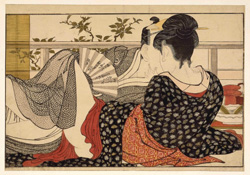 In early modern Japan, 1600-1900, thousands of sexually explicit works of art were produced, known as ‘spring pictures’ (shunga). Tim Clark is currently curating a major shunga exhibition at the British Museum, which celebrates this often tender, funny and beautiful erotic art-form, produced by some of the great masters of Japanese art such as Utamaro and Hokusai. Shunga is in some ways a unique phenomenon in pre-modern world culture, in terms of the quantity, the quality and the nature of the art that was produced. Showing some key works from the exhibition, Tim will explore important questions about what is shunga, how it circulated and to whom, and why it was produced. In particular, he will introduce the social and cultural contexts for sex art in Japan, reaffirming the significance of shunga in Japanese art history. In early modern Japan, 1600-1900, thousands of sexually explicit works of art were produced, known as ‘spring pictures’ (shunga). Tim Clark is currently curating a major shunga exhibition at the British Museum, which celebrates this often tender, funny and beautiful erotic art-form, produced by some of the great masters of Japanese art such as Utamaro and Hokusai. Shunga is in some ways a unique phenomenon in pre-modern world culture, in terms of the quantity, the quality and the nature of the art that was produced. Showing some key works from the exhibition, Tim will explore important questions about what is shunga, how it circulated and to whom, and why it was produced. In particular, he will introduce the social and cultural contexts for sex art in Japan, reaffirming the significance of shunga in Japanese art history.
*This talk will include content of a sexually explicit nature. Parental guidance advised for under 16s.
The exhibition Shunga: sex and pleasure in Japanese art will be held at the British Museum from 3 October 2013 – 5 January 2014.
Image: Kitagawa Utamaro; ‘Lovers in the upstairs room of a teahouse’ from Utamakura (Poem of the Pillow); c. 1788. ‘Sheet from a colour-woodblock printed album’ © The Trustees of the British Museum
Tim Clark
Tim Clark is Head of the Japanese Section in the Department of Asia at the British Museum. He has authored and co-authored many books about aspects of Japanese art, including ukiyo-e painting, Kyosai, Utamaro, early ukiyo-e images of Mt Fuji, Hokusai, Osaka ukiyo-e and Kuniyoshi. He curated and wrote the catalogue for the 2009 exhibition Kuniyoshi from the Arthur R. Miller Collection, held at the Royal Academy of Arts, London. In 2011 he published a small monograph for British Museum Press, Hokusai’s Great Wave. Tim is curator of the exhibition and co-editor, with C. Andrew Gerstle, Aki Ishigami and Akiko Yano of the catalogue Shunga: sex and pleasure in Japanese art (2013).
Free but booking is essential at www.dajf.org.uk/bookin |



 In early modern Japan, 1600-1900, thousands of sexually explicit works of art were produced, known as ‘spring pictures’ (shunga). Tim Clark is currently curating a major shunga exhibition at the British Museum, which celebrates this often tender, funny and beautiful erotic art-form, produced by some of the great masters of Japanese art such as Utamaro and Hokusai. Shunga is in some ways a unique phenomenon in pre-modern world culture, in terms of the quantity, the quality and the nature of the art that was produced. Showing some key works from the exhibition, Tim will explore important questions about what is shunga, how it circulated and to whom, and why it was produced. In particular, he will introduce the social and cultural contexts for sex art in Japan, reaffirming the significance of shunga in Japanese art history.
In early modern Japan, 1600-1900, thousands of sexually explicit works of art were produced, known as ‘spring pictures’ (shunga). Tim Clark is currently curating a major shunga exhibition at the British Museum, which celebrates this often tender, funny and beautiful erotic art-form, produced by some of the great masters of Japanese art such as Utamaro and Hokusai. Shunga is in some ways a unique phenomenon in pre-modern world culture, in terms of the quantity, the quality and the nature of the art that was produced. Showing some key works from the exhibition, Tim will explore important questions about what is shunga, how it circulated and to whom, and why it was produced. In particular, he will introduce the social and cultural contexts for sex art in Japan, reaffirming the significance of shunga in Japanese art history.